As a proud plant parent, I understand the joy that comes with watching your plants grow and flourish. One of my all-time favorites is the Fiddle Leaf Fig, with its large, vibrant leaves that can brighten up any room. However, I’ve also experienced the frustration of my fiddle leaf fig not growing as many leaves as I would like. After doing some research and experimenting with different methods, I’ve finally found a combination of techniques that have helped my fiddle leaf fig thrive. In this article, I will share my experience and provide a step-by-step guide on how to grow more leaves on fiddle leaf fig plants.
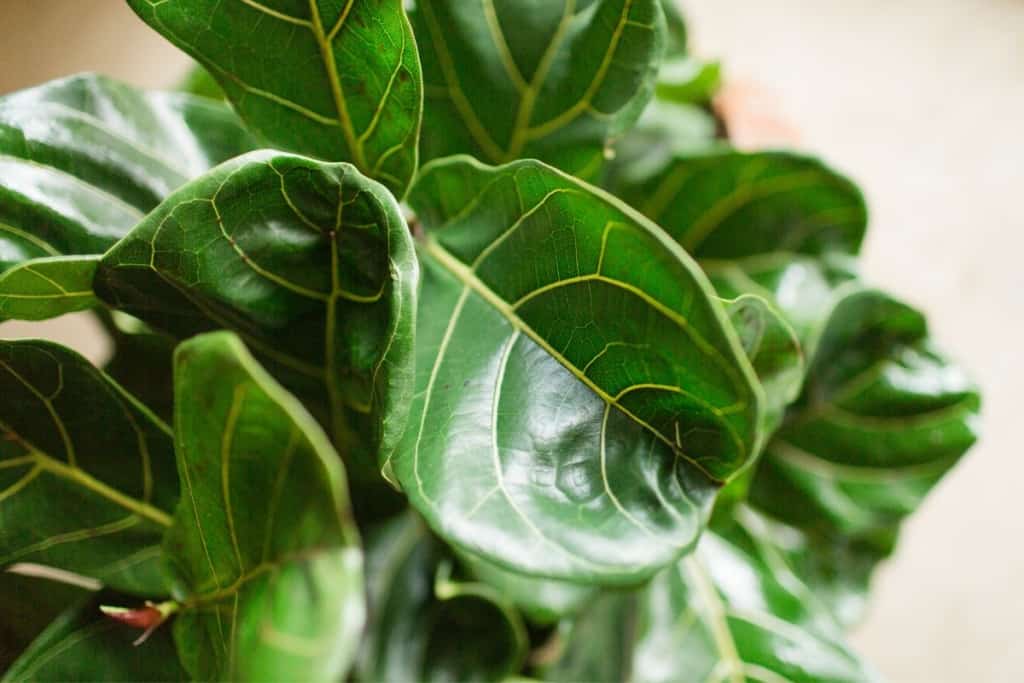
Contents
- 1 How To Grow More Leaves On Fiddle Leaf Fig
- 2 Frequently Asked Questions
- 2.1 How often should fiddle leaf fig grow new leaves?
- 2.2 Do fiddle leaf figs only grow leaves from the top?
- 2.3 Why is my fiddle leaf fig growing small leaves?
- 2.4 Why is my fiddle leaf fig not growing leaves?
- 2.5 What to do if fiddle leaf loses all leaves?
- 2.6 Can fiddle leaf fig recover from losing all leaves?
- 2.7 Will a fiddle leaf fig branch naturally?
- 2.8 Why can’t I get my fiddle leaf fig to branch?
- 3 Parting Words
How To Grow More Leaves On Fiddle Leaf Fig
1. Prune your Fiddle Leaf Fig
Pruning is an essential part of maintaining the health and appearance of your fiddle leaf fig. When done correctly, pruning can encourage more leaf growth and a fuller, bushier plant. Here’s how to prune your fiddle leaf fig to encourage leaf growth:
- Choose the right tools: To avoid damaging your plant, use clean, sharp pruning shears. Dull blades can tear the plant tissue, making it more difficult for the plant to heal and grow new leaves.
- Identify the areas to prune: Look for any dead, diseased, or damaged leaves and branches. These should be removed to prevent them from taking nutrients away from the healthy parts of the plant. Additionally, pruning the top of the plant can encourage the growth of new branches and leaves.
- Cut at a 45-degree angle: When pruning, make a clean cut at a 45-degree angle just above the node, which is where the leaf meets the stem. This will help the plant heal more quickly and prevent any potential diseases from entering the plant.
- Use pruning to shape the plant: Pruning can also be used to shape the plant to your desired size and shape. To encourage bushier growth, prune the top of the plant to promote branching. Prune the tips of the stems to encourage the plant to grow fuller, with more leaves.
- Give the plant time to recover: After pruning, give your plant time to recover before pruning it again. This will allow it to grow new leaves and branches and replenish its energy reserves.
By pruning your fiddle leaf fig regularly, you can encourage healthy leaf growth and maintain a beautiful and vibrant plant.
Related Post:
How To Propagate Fiddle Leaf Fig Successfully
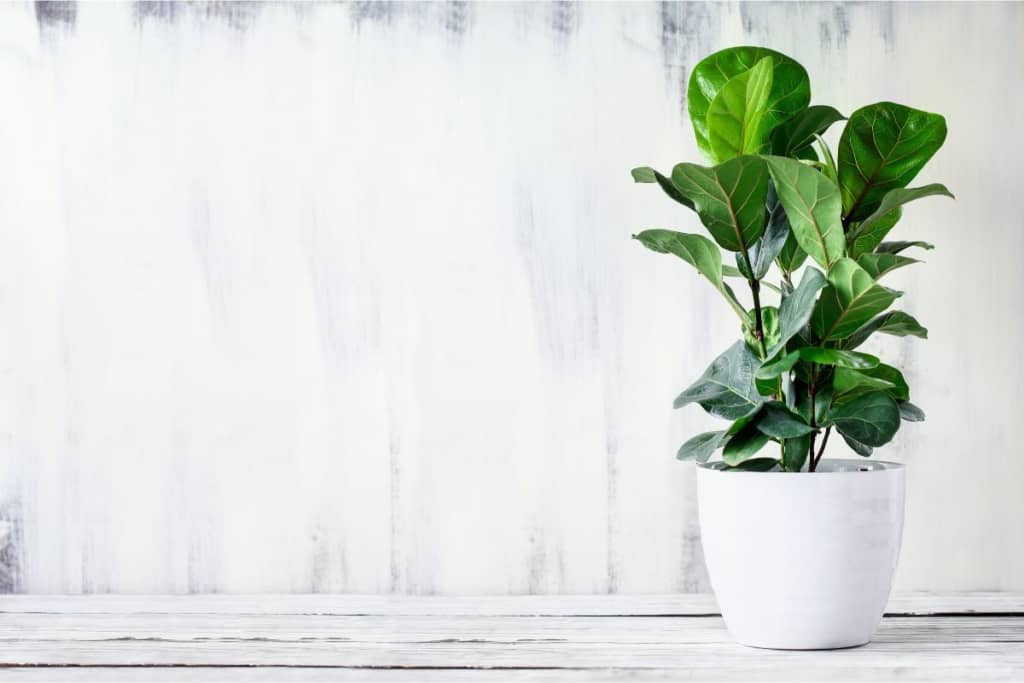
Related Post:
Leaning Fiddle Leaf Fig (8 Causes & Solutions)
2. Notch Your Fiddle Leaf Fig
Notching is another technique that can be used to encourage new growth and promote fuller foliage. Notching involves making a small cut on the stem of your fiddle leaf fig, which will encourage the growth of new branches and leaves.
Single-Cut Method Notching
To notch your fiddle leaf fig, start by locating the stem where you would like to encourage new growth. Make a small cut with a clean and sharp knife, about 1/4 inch deep into the stem. This cut should be made just above a node, where the leaf meets the stem.
Double-Cut Notching
Alternatively, you can use the double-cut notching method. This method involves making two small cuts, about 1/4 inch apart, just above a node. Then, using a clean and sharp knife, remove the small strip of bark between the two cuts.
How Long Does Notching Take to Work?
Notching can take anywhere from a few weeks to several months to see the effects. The time it takes for new growth to appear will depend on several factors, such as the age and health of your fiddle leaf fig, the time of year, and the amount of light and humidity in its environment.
How to Encourage Successful Notching
To encourage successful notching, ensure that your fiddle leaf fig is in a warm and humid environment, with plenty of bright, indirect sunlight. You can also use a rooting hormone to stimulate the growth of new branches and roots. Additionally, make sure to keep your plant well-watered and fertilized to support its growth.
3. Pinch Your Fiddle Leaf Fig
Pinching is another technique that can be used to promote new growth and fuller foliage. Pinching involves using your fingers to remove the tip of a stem or branch, which will encourage the growth of new shoots and leaves.
To pinch your fiddle leaf fig, start by examining the tips of your stems or branches. Look for any new growth that is just starting to emerge, and use your fingers to gently pinch it off. This will stimulate the growth of new shoots and leaves.
Is Notching the Same As Pinching and Pruning?
While notching, pinching, and pruning all involve removing parts of the plant, each technique has a distinct purpose and method. Pinching involves removing the tip of a stem to encourage bushier growth. Pruning is the removal of entire branches to manage the shape and size of the plant. Notching, on the other hand, is a method of encouraging new growth on existing branches.
4. Adjust Lighting and Humidity
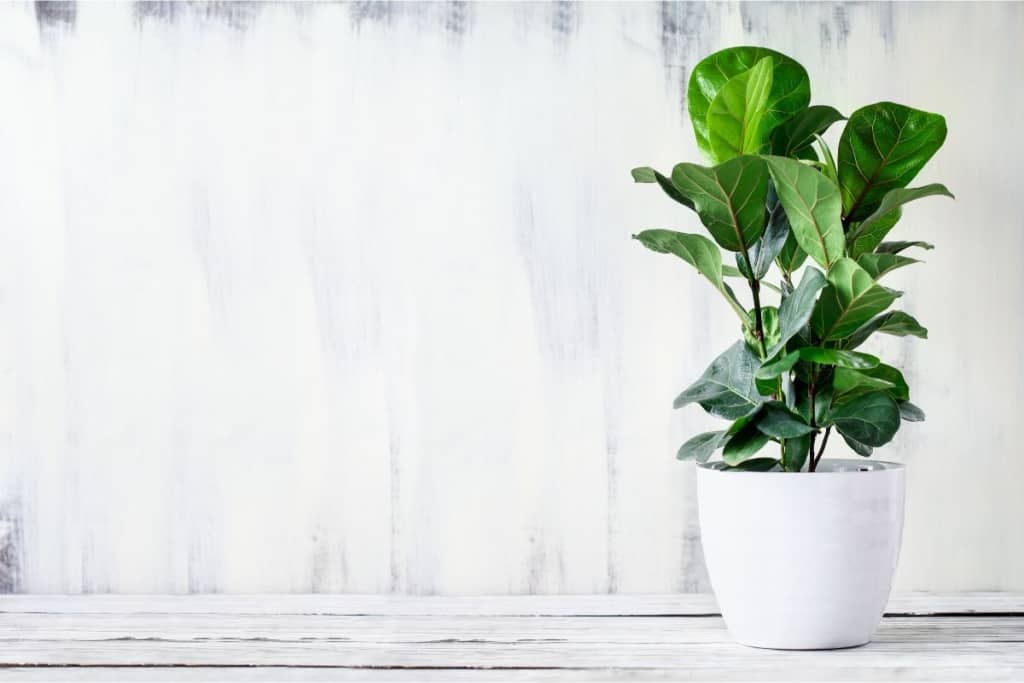
Lighting and humidity play a crucial role in the growth and health of your fiddle leaf fig. Inadequate lighting can cause your plant to become weak and spindly, while too much direct sunlight can burn its leaves. The ideal location for a fiddle leaf fig is near a bright, east-facing window that receives indirect light for most of the day.
On the other hand, humidity is essential to help your fiddle leaf fig thrive. Fiddle leaf figs naturally grow in rainforests, where the air is humid and moist. Therefore, indoor environments can be challenging for them, especially in dry areas or during the winter months when indoor heating can dry out the air. To combat this, you can use a humidifier to increase the humidity levels around your fiddle leaf fig, or you can place a tray of water near the plant, ensuring that it doesn’t sit directly in the water.
Inadequate lighting and low humidity levels can both contribute to a lack of leaf growth and can make your fiddle leaf fig more susceptible to pests and diseases. Therefore, maintaining the ideal lighting and humidity conditions is essential to growing healthy and vibrant fiddle leaf figs with plenty of leaves.
5. Fertilize Your Fiddle Leaf Fig
One of the primary nutrients that fiddle leaf figs need is nitrogen, which is essential for promoting leaf growth. Fertilizers high in nitrogen can help promote healthy growth and encourage the plant to produce more leaves. However, it’s also important to provide the plant with other essential nutrients, such as phosphorus and potassium, which can promote overall plant health.
When fertilizing your fiddle leaf fig, it’s important to do so on a consistent schedule. This can help ensure that the plant is getting the nutrients it needs to thrive. However, it’s also important not to overdo it. Applying too much fertilizer can cause the plant to burn, which can harm or even kill it. Follow the instructions on the fertilizer package carefully and adjust the frequency of fertilizing according to the plant’s needs.
In addition to choosing the right type of fertilizer and fertilizing on a consistent schedule, it’s also important to provide your fiddle leaf fig with adequate water and sunlight. Fertilizers work best when the plant is healthy and has the resources it needs to absorb the nutrients. By providing the right balance of sunlight, humidity, water, and nutrients, you can help your fiddle leaf fig thrive and produce more leaves.
Related Post:
Do Fiddle Leaf Figs Like Coffee Grounds? (Benefits & Risks)
6. Repot Your Fiddle Leaf Fig
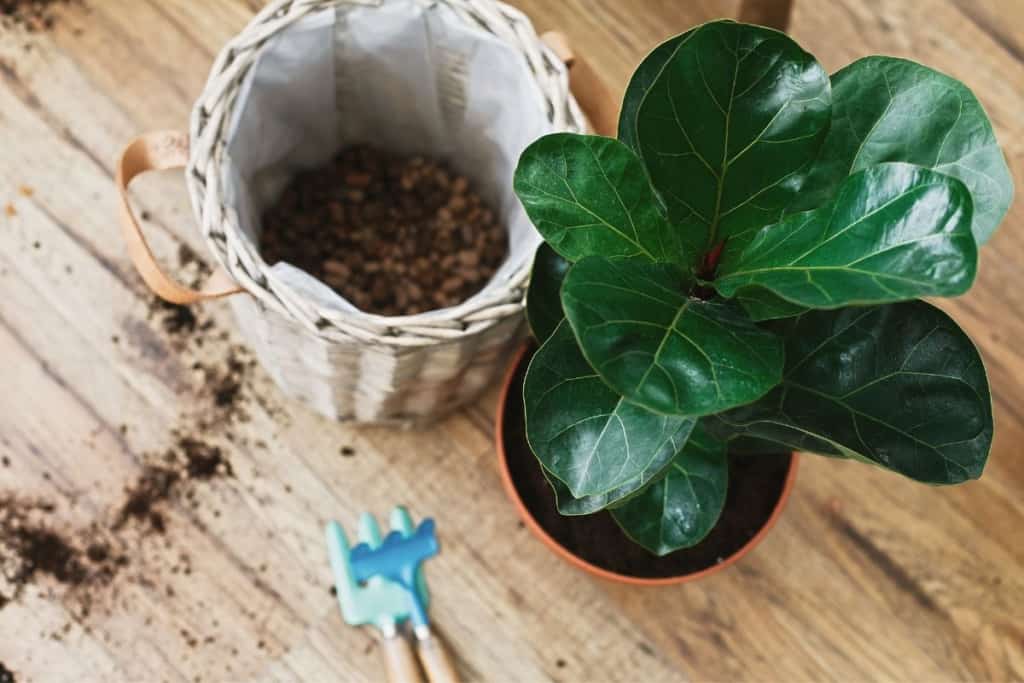
Repotting can be the key to growing more leaves on your fiddle leaf fig, as it provides the plant with fresh soil and more room for growth. Over time, your fiddle leaf fig may outgrow its pot and become root-bound, which means that the roots have grown so much that they are cramped and have nowhere to go. This can cause a variety of problems, such as stunted growth, yellowing leaves, and even plant death.
To repot your fiddle leaf fig, you will need a new pot that is one or two sizes larger than the current pot, fresh potting soil, and a tarp or large garbage bag to contain any mess. First, carefully remove the plant from its current pot, being sure to loosen any tangled roots. Then, gently remove any dead or damaged roots and trim back any long, leggy roots to encourage new growth.
Next, add a layer of fresh potting soil to the bottom of the new pot and place the fiddle leaf fig in the center. Fill in the space around the plant with more soil, being sure to gently pack it in to avoid any air pockets. Water the plant thoroughly and place it in a spot with good lighting and humidity.
It’s important to note that you should only repot your fiddle leaf fig when it is actively growing, which is typically in the spring or early summer. Repotting during the dormant season can shock the plant and lead to further problems. Additionally, be sure to avoid over-potting, as too much soil can lead to waterlogging and root rot.
7. Understand Your Plant’s Natural Growth Cycle
Understanding the natural growth cycle of your fiddle leaf fig is crucial for promoting healthy leaf growth. Fiddle leaf figs have a distinct growth pattern that can be broken down into four phases: the juvenile phase, the transitional phase, the adult phase, and the senescent phase.
During the juvenile phase, your fiddle leaf fig will be growing rapidly and producing lots of new leaves. At this stage, it’s important to give your plant plenty of water and fertilization to promote healthy growth. Once your plant reaches the transitional phase, it will slow down its growth and focus more on producing a strong trunk.
As your fiddle leaf fig enters the adult phase, it will produce fewer leaves but they will be larger and more mature. This is when you’ll start to see your plant’s unique shape and form develop. During this phase, it’s important to maintain a consistent watering and fertilization routine to support your plant’s continued growth.
Finally, your fiddle leaf fig will enter the senescent phase, which is marked by a gradual decline in growth and leaf production. At this point, it’s important to focus on maintaining the health of your plant rather than promoting new growth. Regular maintenance such as pruning and repotting can help keep your plant healthy and strong even as it enters this phase.
Frequently Asked Questions
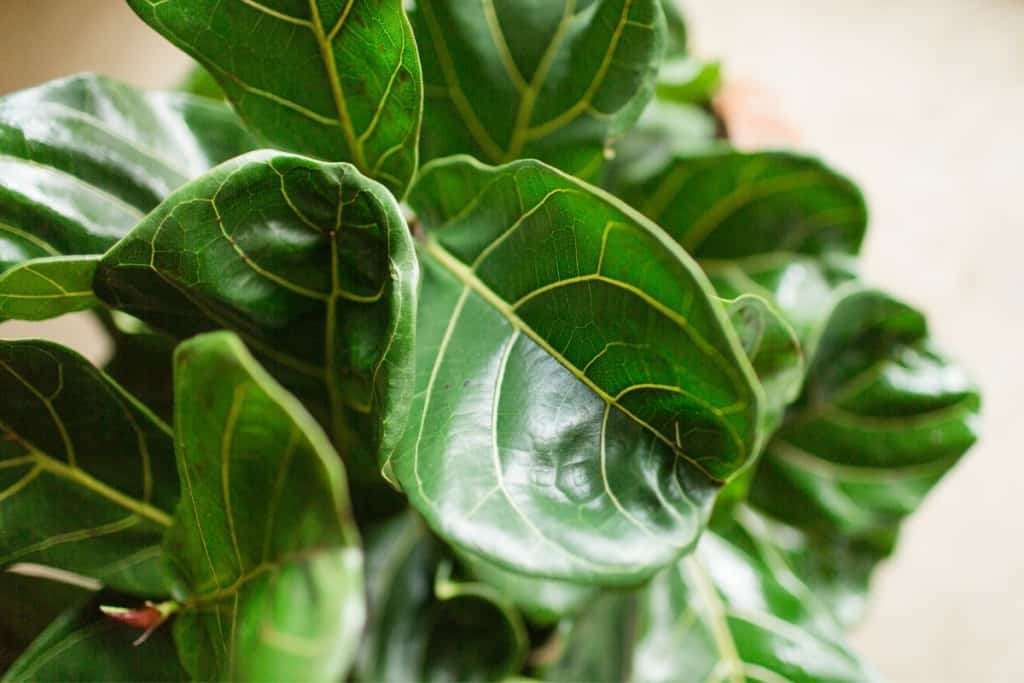
How often should fiddle leaf fig grow new leaves?
The frequency with which a fiddle leaf fig grows new leaves can vary based on various factors such as the age and size of the plant, the amount of light and humidity it receives, and the frequency and quality of fertilization.
In general, a healthy fiddle leaf fig can produce new leaves every few weeks during the growing season, which typically occurs in the spring and summer. However, the plant may slow down its growth and leaf production during the winter months when there is less light and cooler temperatures. It’s important to monitor your plant’s growth and adjust its care routine as needed to ensure it stays healthy and continues to produce new leaves over time.
Do fiddle leaf figs only grow leaves from the top?
No, fiddle leaf figs can grow leaves from any part of the stem, not just the top. In fact, pruning the top of the plant can encourage new growth on the lower branches, leading to a bushier and more balanced plant.
Additionally, notching or pinching the stem can also encourage growth on the lower branches. It’s important to keep in mind that fiddle leaf figs have a natural tendency to grow towards the light, so it’s best to rotate the plant periodically to promote even growth.
Why is my fiddle leaf fig growing small leaves?
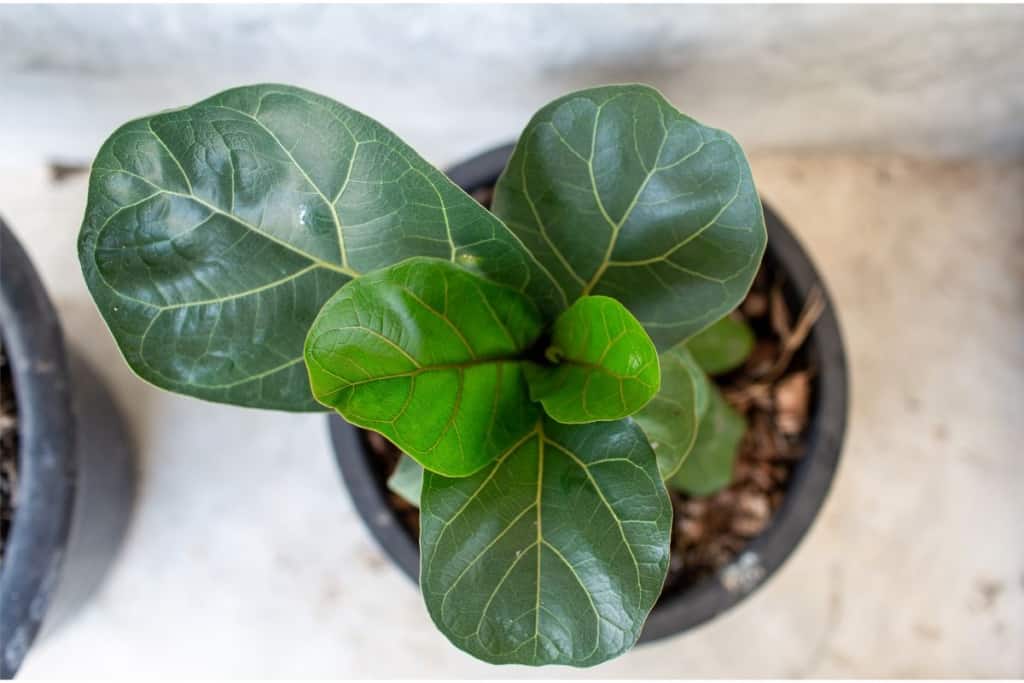
There are several reasons why your fiddle leaf fig might be growing small leaves, including:
- Lack of light: If your fiddle leaf fig isn’t getting enough light, it may produce smaller leaves. Make sure your plant is getting bright, indirect light for at least 6-8 hours a day.
- Lack of nutrients: Fiddle leaf figs require certain nutrients to grow large, healthy leaves. Make sure you are fertilizing your plant regularly with a balanced fertilizer.
- Overwatering or underwatering: Overwatering or underwatering can stress your plant and cause it to produce smaller leaves. Make sure you are watering your plant on a consistent schedule and that the soil is well-draining.
- Temperature fluctuations: Fiddle leaf figs prefer a stable temperature and don’t do well in drafts or extreme temperature fluctuations. Make sure your plant is in a spot that is away from air conditioning or heating vents.
- Rootbound: If your fiddle leaf fig has outgrown its pot, it may produce smaller leaves. Check the roots and consider repotting the plant if the roots are taking up all the available space in the pot.
Overall, it’s important to provide your fiddle leaf fig with consistent care and to address any issues as soon as you notice them to ensure your plant produces healthy, large leaves.
Why is my fiddle leaf fig not growing leaves?
If your fiddle leaf fig isn’t growing new leaves, there may be a few reasons for this. One common reason is that the plant isn’t getting enough light. Fiddle leaf figs require bright, indirect sunlight to grow and thrive. If the plant is in a location that doesn’t receive enough light, it may not produce new leaves.
Another reason your fiddle leaf fig may not be growing new leaves is that it’s not getting enough water or nutrients. The soil should be kept moist but not too wet, and the plant should be fertilized regularly with a balanced fertilizer.
Overwatering can also be a problem for fiddle leaf figs. If the plant is sitting in water or the soil is constantly wet, the roots can become waterlogged and start to rot. This can lead to stunted growth and even death.
In some cases, your fiddle leaf fig may not be growing new leaves because it’s reached its natural limit. Fiddle leaf figs are known for their slow growth, and they may only produce a few new leaves each year. If your plant is healthy and otherwise thriving, this may simply be its natural growth pattern.
It’s also important to keep in mind that fiddle leaf figs can be sensitive to changes in their environment. Moving the plant to a new location or changing the temperature or humidity levels can all affect its growth. Give your plant time to adjust to its new surroundings before you start worrying about its growth.
What to do if fiddle leaf loses all leaves?
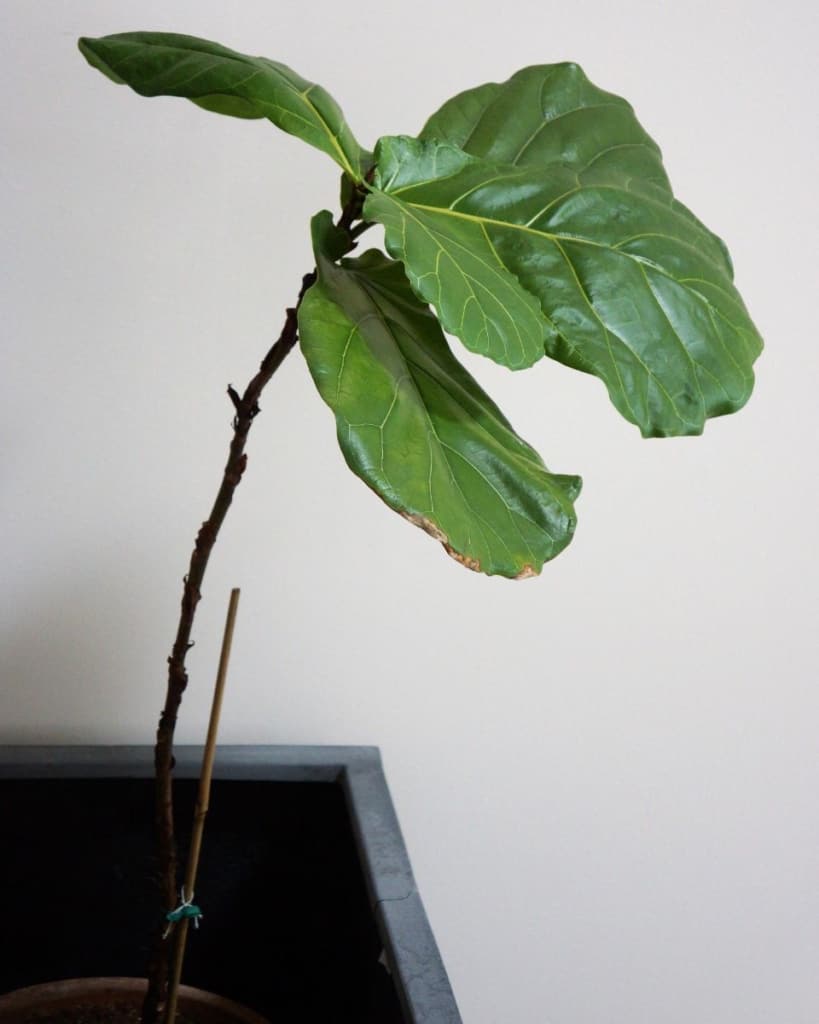
If your fiddle leaf fig has lost all its leaves, there are a few steps you can take to try to revive it:
- Don’t panic: While it can be distressing to see your plant with no leaves, don’t give up hope just yet. Fiddle leaf figs are resilient plants and can often recover even after losing all of their leaves.
- Determine the cause: Try to identify the reason for the leaf loss. Overwatering, underwatering, low light, pests, and diseases can all cause a fiddle leaf fig to drop its leaves. Addressing the underlying issue is important to prevent further damage and promote new growth.
- Assess the stem: Check the stem of the plant for any signs of rot or damage. If the stem is soft, mushy, or discolored, it may be too late to save the plant.
- Adjust the care routine: Based on the cause of the leaf loss, adjust your care routine. If you were overwatering, allow the soil to dry out completely before watering again. If you were underwatering, water the plant thoroughly and consider adding a humidifier to increase the humidity around the plant.
- Provide adequate light: Fiddle leaf figs require bright, indirect light to grow and thrive. Place the plant near a bright window, but avoid direct sunlight, which can scorch the leaves.
- Be patient: It may take several weeks or even months for your fiddle leaf fig to recover and start growing new leaves. Be patient and continue to care for the plant as it regains its strength.
If your fiddle leaf fig does not show signs of recovery after several weeks, it may be time to consider replacing it.
Can fiddle leaf fig recover from losing all leaves?
Fiddle leaf figs can recover from losing all their leaves, but it depends on the cause of the leaf loss and the care the plant receives after the leaves fall off. If the cause of the leaf loss was environmental, such as overwatering, underwatering, or incorrect lighting, correcting these issues and providing proper care can help the plant recover. However, if the cause of the leaf loss was due to disease, pests, or root rot, it may be more difficult for the plant to recover.
In some cases, a fiddle leaf fig that has lost all of its leaves may still have a healthy root system, which can aid in the plant’s recovery. It’s important to remove any dead or rotted parts of the plant and give the remaining stem and roots time to heal and recover.
Additionally, providing the right care after leaf loss can help the plant recover more quickly. This includes making sure the plant has adequate lighting, proper watering, and proper fertilization. It may take several months for a fiddle leaf fig to recover from losing all of its leaves, and during this time, it’s important to be patient and provide consistent care.
Will a fiddle leaf fig branch naturally?
Yes, a fiddle leaf fig can branch naturally as part of its growth process. As the plant matures, it will start to produce lateral buds, which can develop into new branches. This process can be encouraged by providing optimal growing conditions, such as adequate lighting, humidity, and fertilizer.
Pruning the plant can also encourage branching, as it stimulates new growth and redirects the plant’s energy towards developing new shoots. However, it’s important to note that every plant is different and some may branch more readily than others. Additionally, some cultivars of fiddle leaf figs may be less prone to branching than others.
Why can’t I get my fiddle leaf fig to branch?
If your Fiddle Leaf Fig is not branching, there could be several reasons why. One reason may be that the plant is not getting enough light, which can prevent the growth of new branches. Another reason could be that the plant is not getting enough nutrients, specifically phosphorus, which is crucial for promoting branching.
Additionally, pruning and notching can also encourage branching by redirecting the plant’s energy toward new growth points. If you’ve been pruning or notching your Fiddle Leaf Fig but it still isn’t branching, it may be because you’re not doing it correctly or you’re not giving the plant enough time to respond to the changes.
Parting Words
In conclusion, growing a fiddle leaf fig can be a rewarding experience, but it requires proper care and attention. To encourage leaf growth, it’s essential to prune your plant, notch or pinch its branches, and provide it with the right lighting, humidity, and fertilization. Additionally, understanding your plant’s natural growth cycle can help ensure optimal growth and health.
Remember that growing a healthy and vibrant fiddle leaf fig takes time, patience, and effort. It’s crucial to observe your plant’s growth and adjust your care routine accordingly. With the right knowledge and approach, you can create the perfect environment for your fiddle leaf fig to thrive and produce beautiful, lush leaves.
